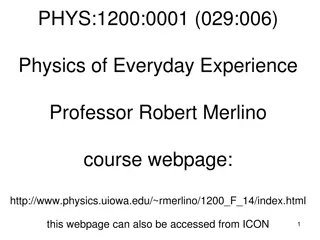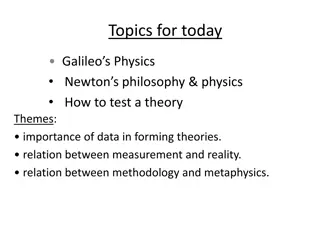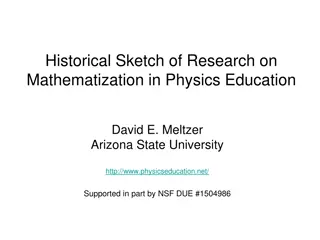UIL Physics 2021-2022: Topics, Questions, and Study Text Overview
In the UIL Physics 2021-2022 competition, questions will cover a range of topics from "The God Equation" by Michio Kaku to concepts in astronomy, measurement, motion, forces, energy, circuits, optics, modern physics, and more. Each test will increase in difficulty, with questions progressing through different levels of complexity. Directed study text includes chapters mapped to various stages of the competition. The process involves generating potential questions, assessing difficulty levels, and finalizing details for each question.
Download Presentation

Please find below an Image/Link to download the presentation.
The content on the website is provided AS IS for your information and personal use only. It may not be sold, licensed, or shared on other websites without obtaining consent from the author. Download presentation by click this link. If you encounter any issues during the download, it is possible that the publisher has removed the file from their server.
E N D
Presentation Transcript
UIL Physics UIL Physics 2021-2022
Topics by Question: Physics Questions P1 P3 will be from The God Equation by Michio Kaku. Physics Question P4 will be from the field of Astronomy. Physics Question P5 will be about Measurement/Dimensional Analysis/Significant Figures/Order of Magnitude. Physics Question P6 will be about Uniformly Accelerated Motion. Physics Question P7 will be about Forces. Physics Question P8 will be about Work/Energy/Power/Momentum.
Topics by Question: Physics Question P9 will be about Circular and Rotational Motion/Equilibrium. Physics Question P10 will be about Waves/Sound/ Harmonic Motion. Physics Question P11 will be about Fluid Statics and Dynamics/ Thermodynamics. Physics Question P12 will be about DC Circuits/Resistors/Capacitors. Physics Question P13 will be about Electric Fields and Forces/Electric Potential/Gauss Law. Physics Question P14 will be about Magnetic Fields and Forces/Magnetic Materials/Ampere s Law.
Topics by Question: Physics Question P15 will be about Faraday s Law/Induction/EM Oscillation and Waves/AC Circuits. Physics Question P16 will be about Geometric Optics/Wave Optics. Physics Question P17 will be about Modern Physics/Quantum Physics. Physics Question P18 will be about Nuclear Physics/Particle Physics. Physics Question P19 will be a wildcard question from the topics traditionally covered in a Physics 1 course. Physics Question P20 will be a wildcard question from the topics traditionally covered in a Physics 2 course.
Physics Directed Study Text The God Equation by Michio Kaku Directed Study Questions Invitational A chapters 1-2 Invitational B chapters 1-2-3 District chapters 3-4 Regional chapters 4-5-6 State chapters 5-6-7
Each Test Increases in Difficulty Each Test Increases in Difficulty for example, consider questions from P07: Forces Level 1: Invitational Level 3: Region and State Level 2: District
The Process Generate two-three potential questions Choose question number Solve, decide if difficulty is correct Topic is determined Decide form: for example P07: inclined or not static or dynamic friction? Work incorrectly, making common mistakes Finalize images constants etc
Sample Physics Questions Sample Physics Questions
The most intense radiation belt in the solar system is a torus of plasma around Jupiter. This torus is associated with which moon of Jupiter? A) Amalthea B) Callisto C) Ganymede D) Io E) Europa
(D) Jupiter has an intense magnetic field, and a magnetosphere similar in behavior to Earth s (though much stronger and larger). Jupiter s volcanically active moon, Io, is caught up in this intense magnetic field. Volcanoes on Io load Jupiter s magnetosphere with up to 1000kg of new material per second. This material is ionized by solar radiation to produce the most intense radiation belt in the solar system, known as the Io plasma torus.
A car travelling at 20.0m/s applies its brakes. After 2.50seconds, the car has slowed to 8.00m/s. How far did the car travel while it was slowing down? A) 15.0 m B) 21.0 m C) 30.0 m D) 35.0 m E) 65.0 m
(D) First, we need to find the acceleration of the car. This is most easily accomplished with the following relationship: ? = ? ?= ? 2.50 = 4.80m/s2. ?? ?0 =8.0 20.0 Now, to find the distance travelled, we can utilize a kinematic equation: ? = ?0+ ?0? +1 2??2= 0 + 20 2.5 +1 2 4.8 2.52= 35.0m
A 14.0kg crate slides down an inclined plane that is tilted at an angle of 51 with respect to the horizontal. The coefficient of friction between the crate and the plane is 0.38. What is the acceleration of the crate? A) 2.34 m/s2 B) 3.27 m/s2 C) 5.27 m/s2 D) 6.17 m/s2 E) 7.62 m/s2
(C) In this situation there are three forces acting on the crate: friction (directed upward parallel to the plane), the normal force (directed upward perpendicular to the plane), and gravity (directed downward). As is customary, we tilt our coordinate system so that down the plane is the positive x-direction, and upward perpendicular to the plane is the y-direction. This means that the normal force goes in the positive y-direction, and the frictional force goes in the negative x-direction. Gravity, on the other hand, is directed at an angle with respect to our tilted coordinate system and must be broken into components. In the tilted x-direction, the gravitational force is ???= ?????? = 14.0 9.8 sin 51 = 106.6N. In the tilted y-direction, we get ??? = ?????? = 14.0 9.8 cos 51 = 86.34N. We now consider the forces in the y-direction. The crate does not accelerate in the y-direction (perpendicular to the plane), so the forces in that direction must sum to zero: ??= ?? ???= ?? 86.34 = 0. This gives us the normal force: ??= 86.34N. Knowing the normal force allows us to find the frictional force: ??= ???= 0.38 86.34 = 32.8N. Since the crate accelerates in the x-direction, we have ??= ???= ??? ??. Plugging in our calculated forces: ???= 106.6 32.8 = 73.8N = (14.0)??. This gives us an acceleration down the plane of ??= 5.27m/s2.
You stand near a long, straight, high power DC electric line. When you are 4.50m away from the power line, you measure the magnetic field strength to be 2600.0 Gauss. To produce this field, what must be the current flowing in the power line? A) 5.85 106 A B) 9.31 106 A C) 1.17 107 A D) 3.68 107 A E) 7.35 107 A
(A) The equation describing the magnetic field produced by a long, straight, current-carrying wire is ? = get ? =2??? ?0. Before using this equation, we must convert the magnetic field to Teslas: ? = 2600? = 2600 10 4? = 0.26?. ?0? 2??. Solving for the current, we Plugging this, and the distance, into the formula gives: ? =2?(4.50)(0.26) 4? 10 7 = 5.85 106?
For the circuit shown, calculate the current passing through the 140 resistor. A) 10.9 mA B) 19.2 mA C) 25.2 mA D) 44.4 mA E) 53.7 mA
(B) The two resistors in the top branch are in series, so their combined resistance is: ?1= 140 + 110 = 250 . This resistance is in parallel with the middle branch, so combining them gives: 1 ?2= 1 1 250+ 190, which gives an equivalent resistance of ?2= 108 . Now this resistance is in series with the side resistor, giving a total circuit resistance of ??= 108 + 230 = 338 . From this we can use Ohm s Law to get the current flowing from the battery: ??=?? ??=15.0 338= 0.0444 A. Because they are in series, this same current flows through the 230 resistor and through the 108 equivalent resistance. Using Ohm s Law again we can get the voltage across the equivalent resistance: ?2= ???2= 0.0444 108 = 4.79 V. Since voltage is the same for resistances in parallel, we know that this is the voltage both across the 190 resistance and across the 250 equivalent resistance. Once again, we can use Ohm s Law this time to get the current flowing in the top branch of the circuit: ?2 ?1=4.79 ?1= resistor and the 110 resistor. In other words, this is the answer to the question: ?140= 0.0192 A = 19.2 mA. 250= 0.0192A. Because they are in series, this current flows through both the 140
A candle that is 13.0cm tall is placed 45.0cm to the left of a concave mirror. The mirror has a radius of curvature of 30.0cm. A real, inverted image of the candle is formed by the mirror. How tall is the image of the candle? A) 3.25cm B) 5.20cm C) 6.50cm D) 9.75cm E) 26.0cm
(C) First, lets find the focal length of the mirror. It is concave, so the focal length is positive, and we know ? =? 2= 15.0cm. Now we can find the location of the image using1 2=30 ?. Plugging in the focal length and object distance: 1 gives an image distance of ? = 22.5cm. ?+1 ?=1 45+1 1 15 ?= Now we can calculate the magnification: ? = ? ?= 22.5 45= 0.5. So, the image height is ?= ? ?= 0.5 13 = 6.50cm. The negative sign just means it is inverted, which is given in the problem. Thus, the answer to the question of how tall is the image would be 6.50cm.
A leaky faucet on your spaceship drips at a steady rate of one drop every 1.30 seconds. How fast would you need to be travelling for a stationary observer to measure the drip rate to be exactly 2.00 seconds? The answers are given as a fraction of the speed of light, c. A) 0.42c B) 0.59c C) 0.65c D) 0.76c E) 0.93c
(D) This is a classic case of relativistic time dilation. The relevant equation for this is ? = 1 ?2 ?2 ? ? ? . This looks daunting, but we can rearrange it to make it a 2 = 1 ?2 little nicer: ?2. Plugging in the faucet drip time for the two 2 = 1 ?2 ?2, which gives ?2 1.30 2.00 ?2= 0.5775, different frames: or a speed of ? = 0.76?. Notice that we never actually have to plug in the value for the speed of light.
A car, initially at rest, accelerates at a constant rate until it reaches the speed limit. It then moves along at a constant speed. Which of the following speed- versus-time graphs best represents the motion of the car?
(A) First, notice that the car is initially at rest this means that the speed must be zero at the beginning this eliminates graphs B and C because they do not start at (0, 0). Second, notice that during the acceleration phase, the acceleration is constant. On a speed-time graph, constant acceleration will appear as a straight line whose slope equals the acceleration. This eliminates plot D because it starts with a curve instead of a line. Finally, after reaching the speed limit, the car moves at a constant speed. On a speed-time graph, a constant speed will appear as a horizontal line. This eliminates E since it has no horizontal line segments. Thus, the plot that best represents the car s motion is graph A it starts at (0, 0), has a diagonal, straight line for the first part (constant acceleration), and then has a horizontal line for the second part (constant speed).
HINTS!! HINTS!! Watch units! Make diagrams with labels (free body diagrams!) Look for order of magnitude answers Work backwards Know your formulas If new to Physics: focus on a few easy topics, skip other questions. Easier question numbers are P05, P06, P08, P10, P12, P16 Read the book! P01-P03 are essentially free points. P19-P20 are laboratory-based. These can often be figured out

























